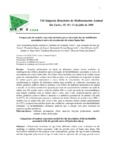Please use this identifier to cite or link to this item:
http://www.alice.cnptia.embrapa.br/alice/handle/doc/526732| Title: | Comparação de modelos regressão aleatória para descrição das herdabilidades associadas à curva de crescimento de ovinos Santa Inês. |
| Authors: | SARMENTO, J. L. R.  TORRES, R. de A.   SOUSA, J. E. R. de   SOUSA, W. H. de   LOBO, R. N. B.   DO Ó, A. O.   REGO NETO, A. A.   CARVALHO, G. B. de   SANTOS, G. V. dos   |
| Affiliation: | José Lindenberg Rocha Sarmento, CPCE/UFPI; RAIMUNDO NONATO BRAGA LOBO, CNPC; Alan Oliveira do Ó, Graduando UFPI. |
| Date Issued: | 2008 |
| Citation: | In: SIMPÓSIO BRASILEIRO DE MELHORAMENTO ANIMAL, 7., 2008, São Carlos, SP. Anais... São Carlos, SP: SBMA: Embrapa Pecuária Sudeste, 2008. 4 f. 1 CD-ROM. |
| Description: | Resumo - Funções polinomiais da idade de diferentes ordens foram avaliadas na modelagem dos efeitos aleatórios para estimação de herdabilidades associadas à curva de crescimento de ovinos Santa Inês. Os efeitos fixos incluídos nos modelos de análise foram grupo de contemporâneo, a idade da ovelha ao parto e os polinômios de Legendre da idade de ordem quatro para representar a curva média de crescimento. Na parte aleatória, consideraram-se funções de diferentes ordens para modelar as variâncias associadas aos efeitos genéticos aditivos direto e materno e aos efeitos de ambiente permanente de animal e da mãe. A variância residual foi ajustada por meio de um polinômio ordinário da idade de ordem seis. De acordo com o valor do critério AIC e o teste da razão de verossimilhança, uma função contínua com as ordens cinco, cinco, sete e três, respectivamente, para os efeitos genéticos aditivos direto e materno e o ambiente permanente de animal e da mãe (k=5573), foi suficiente para ajustar a variância nos dados. Porém, de acordo com o BIC, o modelo com as ordens três, três, cinco e três, para os mesmos efeitos citados anteriormente (k=3353), proporcionou melhor ajuste nas variâncias, conseqüentemente nas herdabilidades estimadas. As herdabilidades estimadas indicam que a seleção para peso resultará em pequenos ganhos genéticos. [Comparison of random regression models for the description of the heritability associated with the growth curve of Santa Ines sheep]. Abstract - Polynomial functions of age from different orders were evaluated on the modeling of random effects associated with the growth curve of Santa Ines sheep. The fixed effects included in the analysis were contemporary groups, the age of dam at lambing and the Legendre polynomial of age of order four to represent the average growth curve. On the random part, functions of different orders were considered for modeling the variances associated with direct and maternal additive genetic effects and with direct and maternal permanent environmental effects. The residual variance was fitted by an ordinary polynomial of age of order six. According to the value of the criteria AIC and the likelihood ratio test, a continual function with the orders five, five, seven and three, respectively, for the direct and maternal additive genetic effects and direct and maternal permanent environmental effects (k=5573) was enough for fitting the variance on data. However, according to the value of the criterion BIC, the model with the orders three, three, five and three (k=3353), for the same effects above, provided best fit in the variances, consequently in the heritability estimated. The estimated heritabilities indicate that the selection for weight will result in small genetic gain. |
| Thesagro: | Genética Animal Melhoramento Genético Animal Ovino |
| Keywords: | Raça Santa Inês Polinômios de Legendre Efeito materno |
| Type of Material: | Artigo em anais e proceedings |
| Access: | openAccess |
| Appears in Collections: | Artigo em anais de congresso (CNPC)  |
Files in This Item:
| File | Description | Size | Format | |
|---|---|---|---|---|
| AACComparacaodemodelosregressao.pdf | 42.26 kB | Adobe PDF |  View/Open |









